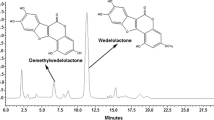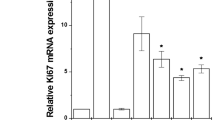Abstract
One hundred and six species of traditional Chinese herbs were collected from the northeast of China, extracted with 60% ethanol, and tested for activity inhibiting histamine release and nitric oxide (NO) production. We found that 18 of the 106 species showed strong histamine-release inhibitory activity (inhibition >80%, 100 μg/ml), of which Bidens parviflora Willd. was recognized to present the strongest activity (inhibition 97.8%, 100 μg/ml). Seven species exhibited strong NO-production inhibitory activity (inhibition >50%, 100 μg/ml) with Pholidota chinensis Lindl. as the most active one (inhibition 86.2%, 100 μg/ml).
Similar content being viewed by others
References
Wang LY, Unehara N, Kitanaka S (2005) Anti-inflammatory activity of new guaiane type sesquiterpene from Wikstroemia indica. Chem Pharm Bull 53(1):137–139
Hirai Y, Takase H, Kobayashi K, Yasuhara T, Nakajima T (1983) Screening test for anti-inflammatory crude drugs based on inhibition effect of histamine release from mast cell. Shoyakugaku Zasshi 37:374–380
Wang N, Yao X, Ishii R, Kitanaka S (2001) Structures and inhibitory effect on nitic oxide production and histamine release of novel polyacetylene glucosides from Bidens parviflora Willd. Chem Pharm Bull 49:938–942
Wang NL, Yao X, Ishii R, Kitanaka S (2003) Bioactive sucrose esters from Bidens parviflora. Phytochemistry 62:741–746
Ishii R, Saito K, Horie M, Shibano T, Kitanaka S, Amnno F (1999) Inhibitory effect of hydrolizable tannins from Melastoma dodecandrum Lour. on nitic oxide production by a murine macrophage-like cell line, RAW 264.7, activated by lipopolysaccharides and interferon-γ. Biol Pharm Bull 22:647–653
Peter L, Sanjoy R, Mario E, Gerald W, Thomas FWH (2003) Oxyresveratrol and resveratrol are potent antioxidants and free radical scavengers: effect on nitrosative and oxidative stress derived from microglial cells. Nitric Oxide 9:64–76
Hu K, Do AJ, Liu HW, Feng HS, Sun QS, Yao XSH (1999) Bioactivity of 247 traditional Chinese medicines against pyricularia. Pharm Biol 37:225–230
Tachibana K, Okada Y, Okuyama T (1995) Search for naturally occurring substances to prevent the complications of diabetes. III. Studies on active substances from Gnaphalium affine D. Don. Nat Med 49:266–268
Wang XR, Wang ZHQ, Shi PCH, Zhou BN (1980) Wang zao zine A, a novel diterpenoid from Isodon amethystoides. Zhongcaoyao 13:12–13
Wang H, Yeon B, Lee JH, Koo T, Kim HS, Hong YS, Ro JR, Lee KS, Lee JJ (2001) Kaurane diterpenes from Isodon japonicus inhibit nitric oxide and prostaglandin E2 production and NFκ-B activation in LPS-stimulated macrophage RAW264.7 cells. Planta Med 67:406–410
Author information
Authors and Affiliations
Corresponding author
Rights and permissions
About this article
Cite this article
Wang, J., Wang, N., Yao, X. et al. Inhibitory activity of Chinese herbal medicines toward histamine release from mast cells and nitric oxide production by macrophage-like cell line, RAW 264.7. J Nat Med 60, 73–77 (2006). https://doi.org/10.1007/s11418-005-0010-6
Received:
Accepted:
Published:
Issue Date:
DOI: https://doi.org/10.1007/s11418-005-0010-6




